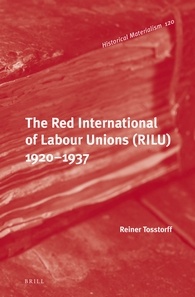Reiner Tosstorff, Johannes Gutenberg-Universität Mainz. Translated by Ben Fowkes.
The ‘Red International of Labour Unions’ (RILU, Russian abbreviation Profintern) was a central instrument for the spreading of international communism during the inter-war period. This comprehensive and scholarly history of the organisation, based on extensive research in the former communist archives in Moscow and East Berlin, sheds significant light on the international trade union movement of the period.
Tosstorff shows how the RILU began as a revolutionary alliance of syndicalists and communists in defiance of the social democratic International Federation of Trade Unions. His text presents a full account of the organisation’s main stages: the decline of the revolutionary wave after World War One, after which many syndicalists left, and others were integrated into the communist parties; the continuation of the RILU as an international communist apparatus; and its dissolution in 1936–7 as part of communism’s popular front policy.
First published in German as Profintern: Die Rote Gewerkschaftsinternationale 1920-1937 by Ferdinand Schöningh, Paderborn, in 2004.
Biographical note
Reiner Tosstorff, Dr. phil. habil., teaches at the history department at Johannes Gutenberg University Mainz. He has published monographs and articles on Spanish history as well as on the international workers’ movement in the twentieth century.
Readership
All those interested in Communist and labour history, the development of trade union movements and organizations on a global scale during the inter-war years.
Table of contents
ACKNOWLEDGEMENTS
ABBREVIATIONS
INTRODUCTION
1. FROM TRADE UNION INTERNATIONALISM TO THE INTERNATIONAL FEDERATION OF TRADE UNIONS
2. IN SEARCH OF A REVOLUTIONARY TRADE UNION INTERNATIONAL
2.1 The International Politics of the All-Russian Central Council of Trade Unions 1917–20
2.2 The Communist International and the Trade-Union Question
2.3 The Impact of the October Revolution on the Revolutionary Syndicalists
2.4 The First Trade Union Contacts: The Question of the International Trade Secretariats and Shliapnikov’s Mission
3. THE INTERNATIONAL TRADE UNION COUNCIL (1920–1)
3.1 Its Foundation
3.2 The Sequel: The Second Comintern Congress and the Trade-Union Question
3.3 The Organisation of the International Trade Union Council
3.4 The Foreign Delegations of the VTsSPS in Autumn 1920: Making Propaganda for the International Trade Union Council
3.5 ‘Amsterdam’ or ‘Moscow’: The Course of the Argument within the IFTU after the Foundation of the International Trade Union Council
3.6 The Syndicalists En Route for Moscow
3.7 The International Trade Union Council, 1920–1: Its Programme, Activities and Organisation
3.8 Towards the Founding Congress: Discussions Between the ITUC and the Delegates
3.9 The Russian Trade Unions and the International Trade Secretariats, 1920–1
4. THE FOUNDING CONGRESS OF THE RED INTERNATIONAL OF LABOUR UNIONS
4.1 The Course of the Congress: The RILU is Established
4.2 Relations Between the Comintern and the RILU
4.3 The Tactics, Organisation and Statutes of the RILU
4.4 The First RILU Congress Draws to a Conclusion
4.5 The Syndicalist Opposition and the Question of the Anarchist Prisoners
4.6 Excursus: The Trade Union Discussion at the Third Comintern Congress
4.7 The Formation of the RILU Leadership: The First Session of the Central Council
4.8 The Creation of the International Propaganda Committees
5. FROM THE FIRST TO THE SECOND CONGRESS OF THE RILU
5.1 Should the RILU Be Disbanded? Resignations and Demands for Liquidation
5.2 The Syndicalists between Moscow and Berlin
5.3 The Development of the RILU as an Organisation and a Political Entity: From the First to the Second Congress
5.4 The International Trade Secretariats and the International Propaganda Committees, 1921–2
5.5 The Second Congress of the Red International of Labour Unions
5.6 Excursus: Organisational Connections Grow Closer: The RILU becomes the Comintern’s International Trade Union Apparatus
6. THE UNITED FRONT THAT DIDN’T HAPPEN IN 1923: THE ROLE OF THE RILU
6.1 From the Hague Congress to the Ruhr Crisis: Fimmen Breaks Ranks
6.2 The Attempt to Achieve the United Front through the International Trade Secretariats
6.3 The Third Session of the Central Council
6.4 A ‘German October’? The Lessons of Defeat
6.5 The RILU as an Organisation at the Beginning of 1924: An Interim Summary
7. THE RILU BETWEEN 1924 AND 1927: IN DANGER OF DISSOLUTION FOR THE SAKE OF INTERNATIONAL TRADE UNION UNITY
7.1 The Trades Union Congress Brings About a Turn to the Left in the IFTU
7.2 Moscow Takes the Road to Unity: The Fifth Comintern Congress and the Third RILU Congress
7.3 The Anglo-Russian Committee and the International Movement for Trade Union Unity
7.4 The Fourth Session of the Central Council
7.5 A Way to Gain New Influence? Initiatives Taken by the RILU Leadership in China and Other Countries
8. THE RILU IN THE CONTEXT OF THE ‘ULTRA-LEFT’ POLICY OF INTERNATIONAL COMMUNISM 1928–34
8.1 Trotskyist Opposition in the RILU? The Nin Affair and the Rift with the Dutch Leftists
8.2 The Radicalisation of the RILU’s Course by Lozovsky and the Sanctioning of the New Approach by the Fourth Congress
8.3 The New Line is Applied Across the Board
8.4 The Sixth Session of the Central Council, The Fifth RILU Congress and the Eighth Session of the Central Council
8.5 Organisational Inflation as a Compensation for Political Decline
9. THE END OF THE ROAD: THE RILU FROM 1934–7
9.1 Trade-Union Unity Under the Banner of the Turn to the Popular Front
9.2 The Seventh Comintern Congress and the International Trade Union Discussion
9.3 The Dissolution of the RILU
9.4 The Sequel: The Russian Trade Unions Again Attempt to Enter the IFTU
CONCLUSION
APPENDICES
Appendix 1: Lozovsky and the Bolsheviks before 1920: A Biographical Sketch
Appendix 2: Biographies of Other Leading Figures
BIBLIOGRAPHY
INDICES
Index of Names
Index of Trade Union Organisations

